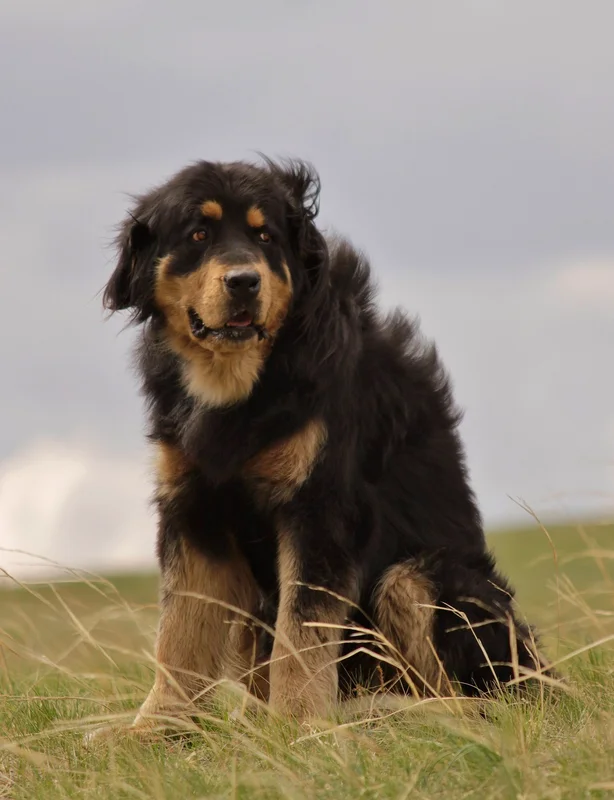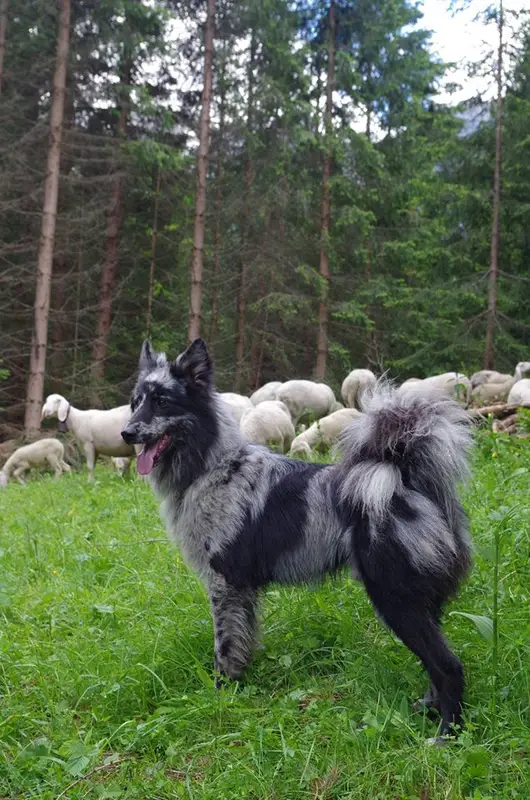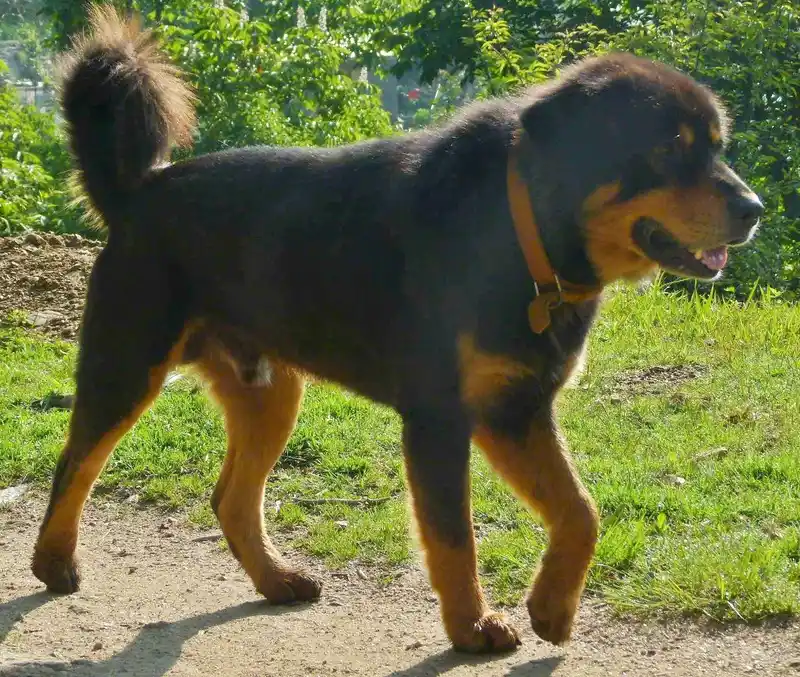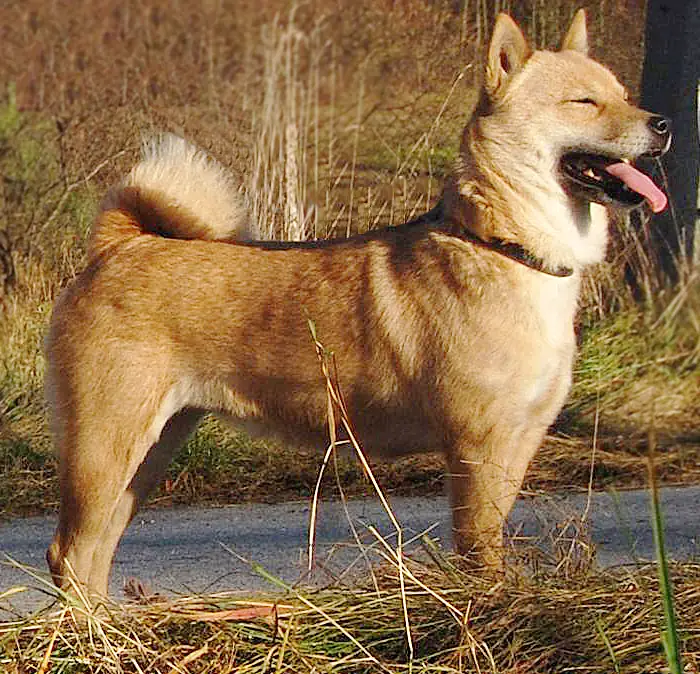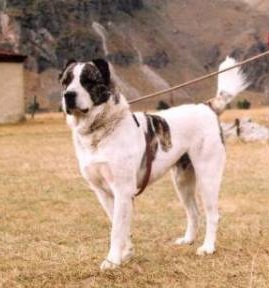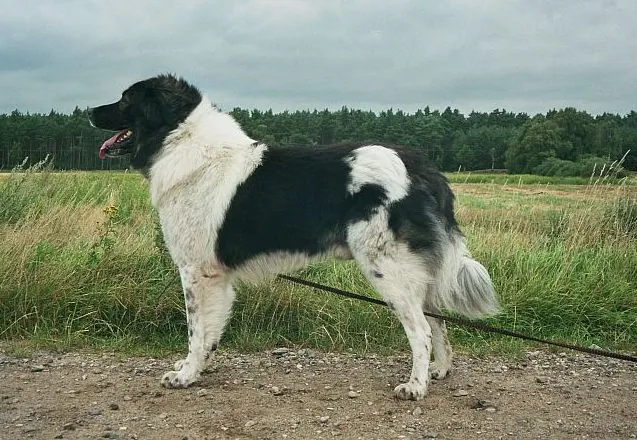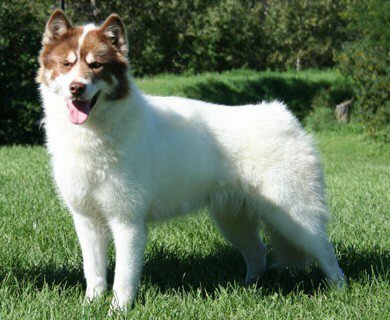Bakharwal Dog
The Bakharwal dog is a loyal livestock guardian from Jammu and Kashmir, known for its protective instincts and affectionate nature.
Overview
🐕Breed Overview
✨Key Traits
💡What Makes Bakharwal Dog Special
The Bakharwal dog's most defining traits include its loyalty, protective nature, and intelligence. These dogs are known for their ability to assess situations and respond appropriately, making them excellent guardians of livestock and property.
Their independent spirit means they require a confident owner who can establish leadership while providing consistent training. The breed's strong work ethic and need for physical activity make them well-suited for families who enjoy outdoor activities and have the space for them to roam.
Their affectionate demeanor towards family members, combined with their natural guarding instincts, makes them both loving companions and reliable protectors.
The Bakharwal dog is an ancient breed with deep roots in the mountainous regions of Jammu and Kashmir, India. Bred by the nomadic Bakharwal and Gujjar tribes, these dogs have been essential companions and protectors of livestock for centuries. Their robust build and thick coat make them well-suited for the harsh Himalayan climate, where they guard sheep and goats from predators like wolves and leopards.
Despite their fierce loyalty and protective instincts, Bakharwal dogs are also known for their affectionate nature towards their families, making them suitable companions for those who understand their needs. However, training can be challenging due to their independent spirit, requiring a firm yet gentle approach to establish trust and respect. As this breed faces the threat of extinction, it is crucial for potential owners to recognize the importance of preserving their lineage and cultural significance.
With proper care, training, and socialization, the Bakharwal dog can thrive as both a loyal guardian and a loving family member.
🎉Fun Facts
Bakharwal dogs are highly adaptable to harsh climates, thanks to their thick double coat.
The Bakharwal dog is known for its exceptional guarding instincts, making it a formidable protector of livestock.
They have been used for centuries by nomadic tribes, showcasing their resilience and versatility in various terrains.
This breed has a strong bond with its family and is known to be affectionate towards children.
Breed Characteristics
Family & Friends
Good Behavior
Get Up & Go
Household Harmony
Temperament & Personality
✨Key Traits
🐕Core Temperament
The Bakharwal dog exhibits a temperament characterized by loyalty, protectiveness, and independence. They are naturally wary of strangers, making them excellent watchdogs, but they are affectionate and gentle with their families.
This breed requires proper socialization from a young age to ensure they are well-adjusted and comfortable around new people and animals. Their strong instincts drive them to patrol their surroundings, and they thrive in environments where they can fulfill their role as guardians.
While they can be stubborn at times, consistent training and positive reinforcement can help shape their behavior.
💫Personality Profile
The Bakharwal dog is known for its strong protective instincts and loyalty to its family. They are independent thinkers, which can make training a challenge, but their intelligence allows them to learn quickly when motivated.
These dogs are typically affectionate with their owners and can be gentle with children, making them suitable family pets. However, they can be territorial and may exhibit aggression towards strangers or other animals if not properly socialized.
Their natural instincts drive them to patrol their surroundings, making them vigilant guardians. Overall, the Bakharwal dog is a devoted companion that thrives in an active environment.
🔊Vocal Tendencies
The Bakharwal dog has a moderate noise level, with a tendency to bark when alerting to potential threats or when they feel their territory is being encroached upon. They may also bark during play or when excited.
While they are not excessive barkers, their vocalizations serve as a warning to intruders and can be quite effective in deterring unwanted visitors. Proper training and socialization can help manage their barking tendencies, ensuring they are more selective about when to vocalize.
Affection & Social Traits
Energy & Activity
Communication Style
Care Requirements
🏃♂️Exercise Requirements
Daily Exercise
The Bakharwal dog requires a significant amount of daily exercise to maintain its physical and mental well-being. Ideally, this breed should engage in at least 90 minutes of exercise each day, which can be broken down into multiple sessions.
Activities such as long walks, running, and playing fetch are excellent for this breed, as they cater to their high energy levels and need for stimulation. Given their historical role as livestock guardians, they thrive in environments where they can roam and patrol their territory.
Puppies should start with shorter, more frequent exercise sessions to build their stamina, while adult dogs benefit from a mix of vigorous activities and mental challenges. Insufficient exercise can lead to behavioral issues such as restlessness, anxiety, and destructive tendencies, making regular physical activity essential for their happiness and health.
Preferred Activities
🏠Living & Adaptability
Space Requirements
The Bakharwal dog thrives in spacious environments, ideally with access to large outdoor areas where they can roam freely. While they can adapt to living in a home, they should not be confined to small spaces or apartments, as their natural instincts and energy levels require room to move.
A house with a large yard or a rural setting is best suited for this breed. Owners in urban areas should ensure that they can provide ample outdoor time and activities to meet the dog's exercise and space needs.
Lack of adequate space can lead to frustration and behavioral problems, as these dogs are accustomed to guarding and patrolling larger territories.
Climate Preference
🍲Feeding Guide
Schedule
Food Types
Portion Size
Special Nutritional Needs
The Bakharwal dog may require a diet rich in protein to support its active lifestyle. It's important to monitor their weight, as obesity can lead to health issues. Regular vet check-ups can help determine any specific dietary needs based on the dog's health and activity level.
✨Grooming Requirements
Grooming Overview
The Bakharwal dog has a thick double coat that requires regular grooming to keep it healthy and free of mats. Weekly brushing is recommended to remove loose hair and prevent tangles, especially during shedding seasons.
Bathing should be done as needed, typically every few months, to maintain coat cleanliness without stripping natural oils. Regular checks of the ears and teeth are also important to prevent infections and dental issues.
Nail trimming should be done monthly to keep their paws healthy and comfortable.
Care Schedule
Brush weekly; bathe every 2-3 months; trim nails monthly.
Health Profile
⚕️Health Care
Regular health care is crucial for the Bakharwal dog's lifespan. Routine veterinary check-ups, vaccinations, and preventive treatments can help detect and address health issues early.
Owners should also be proactive in managing their dog's weight and providing a balanced diet to prevent obesity-related health problems. Regular exercise and mental stimulation are essential for maintaining overall health and well-being throughout the dog's life.
Health Issues Overview
⏳Average Lifespan
Genetic Factors
Genetics play a significant role in the Bakharwal dog's lifespan, with hereditary health issues potentially impacting their longevity. Responsible breeding practices that prioritize genetic diversity can help reduce the prevalence of inherited health conditions.
Potential owners should seek reputable breeders who conduct health screenings for common breed-specific issues. Understanding the genetic background of a dog can provide insights into its potential health risks and lifespan.
Living Conditions
The Bakharwal dog's lifespan can be influenced by various environmental factors, including housing conditions, climate, and social interactions. Dogs living in spacious, outdoor environments with regular exercise tend to live longer, healthier lives.
Exposure to harsh weather conditions without proper shelter can negatively impact their health. Additionally, social interactions with humans and other animals can affect their mental well-being, contributing to a longer lifespan.
Owners should ensure that their Bakharwal dog has a comfortable living space, regular veterinary care, and opportunities for socialization to promote longevity.
🏥Common Health Issues
Hip Dysplasia
Warning Signs
🔬Diagnosis
X-rays and physical examination by a veterinarian.
💊Treatment
Medications, weight management, and in severe cases, surgery.
📝Management Tips
Maintain a healthy weight, provide joint supplements, and avoid excessive jumping or strenuous activities.
Elbow Dysplasia
Warning Signs
🔬Diagnosis
X-rays and veterinary assessment.
💊Treatment
Medications, physical therapy, and surgery if necessary.
📝Management Tips
Regular exercise and maintaining a healthy weight can help manage symptoms.
Patellar Luxation
Warning Signs
🔬Diagnosis
Physical examination and X-rays.
💊Treatment
Surgery may be required in severe cases.
📝Management Tips
Weight management and avoiding high-impact activities can help.
Arthritis
Warning Signs
🔬Diagnosis
Veterinary examination and X-rays.
💊Treatment
Pain management medications and physical therapy.
📝Management Tips
Regular low-impact exercise and joint supplements can help manage symptoms.
Glaucoma
Warning Signs
🔬Diagnosis
Veterinary eye examination.
💊Treatment
Medications or surgery may be necessary.
📝Management Tips
Regular eye check-ups can help catch this condition early.
Obesity
Warning Signs
🔬Diagnosis
Veterinary assessment of body condition score.
💊Treatment
Dietary changes and increased physical activity.
📝Management Tips
Provide a balanced diet and regular exercise to maintain a healthy weight.
🛡️Preventive Care
🔬Hip Evaluation
Hip Evaluation assesses the dog's hip joints for dysplasia and other abnormalities, crucial for preventing mobility issues.
📅 Annually after 2 years of age.
🔬Eye Examination
Eye Examination checks for hereditary eye conditions, including glaucoma and cataracts, important for early detection and treatment.
📅 Every 1-2 years, or as recommended by a veterinarian.
🔬Patellar Luxation Assessment
Patellar Luxation Assessment evaluates the dog's kneecaps for proper alignment and function, essential for preventing joint issues.
📅 Annually after 1 year of age.
Training
🧠Intelligence & Trainability
💪Work Drive
The Bakharwal dog has a strong work drive, stemming from its historical role as a livestock guardian. This breed thrives when given tasks that allow them to utilize their natural instincts, such as herding, guarding, and patrolling.
Engaging them in activities that challenge their intelligence and physical abilities is crucial for their mental well-being. Activities like agility training, obedience exercises, and interactive play can help fulfill their need for mental stimulation.
Without adequate engagement, the Bakharwal dog may exhibit boredom-related behaviors, such as digging or excessive barking.
⚠️Training Considerations
Training the Bakharwal dog can present challenges due to its independent and strong-willed nature. Common behavioral issues include stubbornness and a tendency to assert dominance, which can make obedience training difficult.
To overcome these challenges, it is essential to establish a firm and consistent training routine that emphasizes positive reinforcement. Socialization from a young age is crucial, as it helps the dog become accustomed to various environments, people, and other animals.
Engaging in regular training sessions that incorporate mental stimulation, such as puzzle toys or agility exercises, can also help channel their energy and intelligence effectively.
📝Training Tips
To train a Bakharwal dog successfully, owners should adopt a balanced approach that combines firmness with positive reinforcement. Start with basic commands and gradually introduce more complex tasks, ensuring that training sessions are engaging and varied to hold the dog's interest.
Consistency is key; use the same commands and cues to avoid confusion. Socialization is vital, so expose the dog to different environments, people, and other animals early on.
Patience and persistence are essential, as this breed may take longer to respond to commands compared to more eager-to-please breeds. Building a strong bond of trust will enhance the training experience and encourage cooperation.
History & Heritage
📜Origin Story
The Bakharwal dog originated in the mountainous regions of Jammu and Kashmir, where it was bred by the Bakharwal and Gujjar tribes. These nomadic communities relied on the Bakharwal dog for its exceptional guarding abilities, protecting their livestock from predators and ensuring the safety of their settlements.
The breed's development is closely tied to the pastoral lifestyle of these tribes, who have utilized the dogs for centuries to assist in herding and guarding. As the tribes migrated with their flocks, the Bakharwal dog adapted to various terrains and climates, showcasing its resilience and versatility.
However, with modernization and the decline of traditional herding practices, the breed is now at risk of extinction, prompting urgent conservation efforts to preserve its lineage and cultural significance.
⏳Development History
The Bakharwal dog has a rich history that dates back centuries, primarily developed by the nomadic tribes of Jammu and Kashmir for herding and guarding livestock. Over time, these dogs have adapted to the rugged mountainous terrain and harsh climatic conditions of the region.
Their physical characteristics, such as a robust build and thick coat, have evolved to provide protection against predators like wolves and leopards. The breed has been shaped by selective breeding practices aimed at enhancing their guarding instincts and loyalty to their owners.
Despite their historical significance, the Bakharwal dog is now facing extinction due to changing lifestyles and the decline of traditional pastoral practices.
🛡️Purpose & Historical Role
Historically, the Bakharwal dog has served as a livestock guardian, protecting sheep and goats from predators in the rugged terrains of the Himalayas. Their role extends beyond mere guardianship; they are also companions to the nomadic tribes, providing loyalty and protection.
The breed's strong instincts and protective nature have made them invaluable to shepherds, who rely on them to safeguard their herds during grazing. In addition to herding, these dogs have been known to assist in hunting and tracking, showcasing their versatility and importance in the daily lives of the Bakharwal and Gujjar tribes.
🏺Cultural Significance
The Bakharwal dog holds a significant place in the culture of the Jammu and Kashmir region of India, where it has been bred for centuries by the Bakharwal and Gujjar nomadic tribes. These dogs are not only valued for their role as livestock guardians but also as protectors of settlements against predators and intruders.
Their loyalty and protective instincts have made them integral to the lifestyle of these communities, often accompanying shepherds in the harsh terrains of the Himalayas. The breed's historical importance is underscored by its current endangered status, highlighting the need for conservation efforts to preserve this unique cultural heritage.
Conservation Status
This breed is endangered with low population numbers globally.

